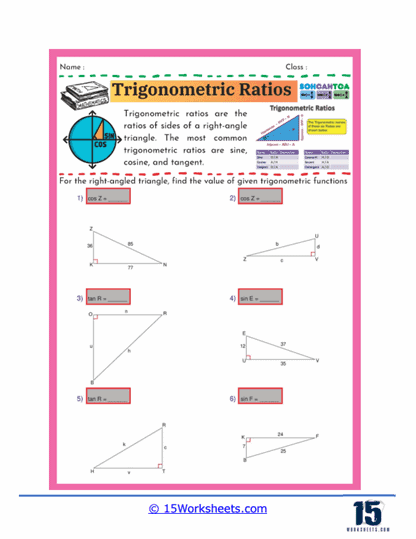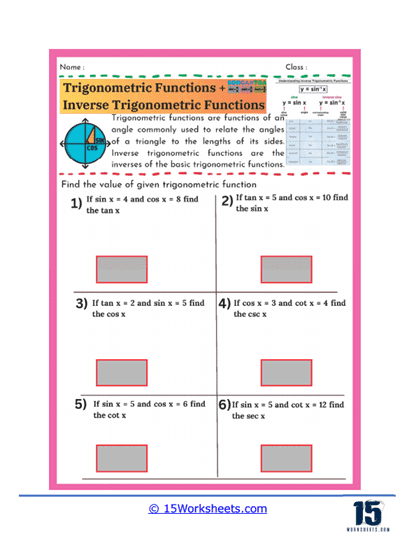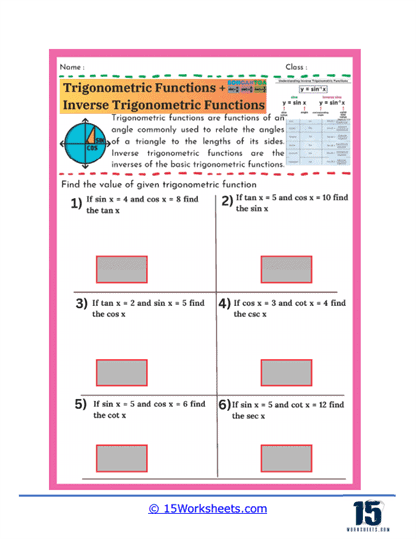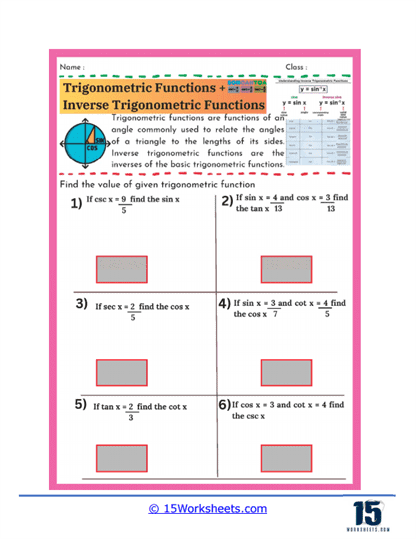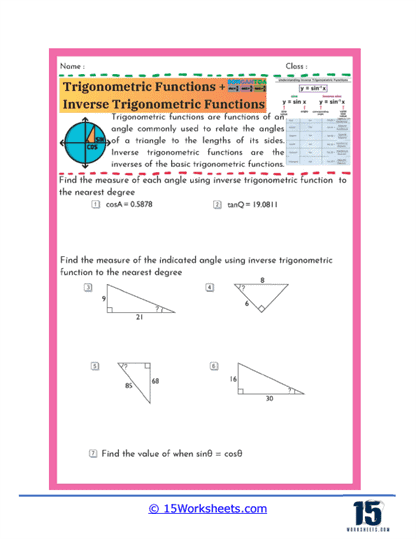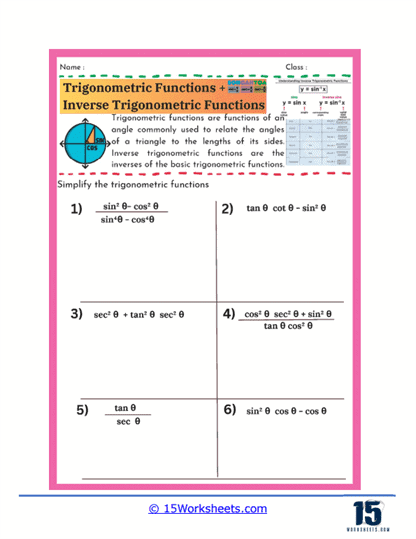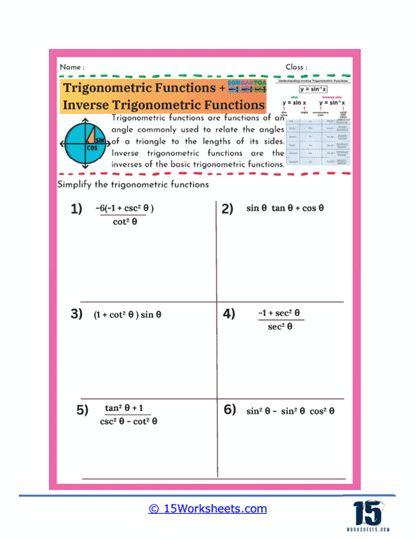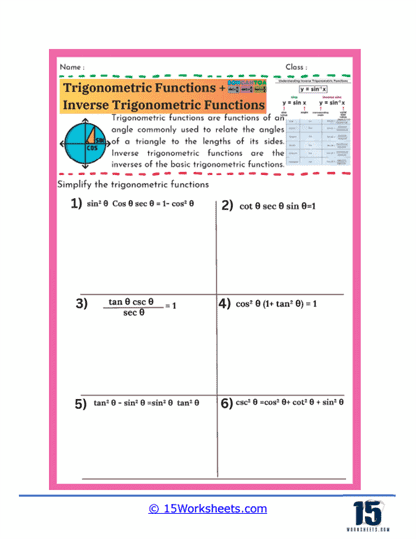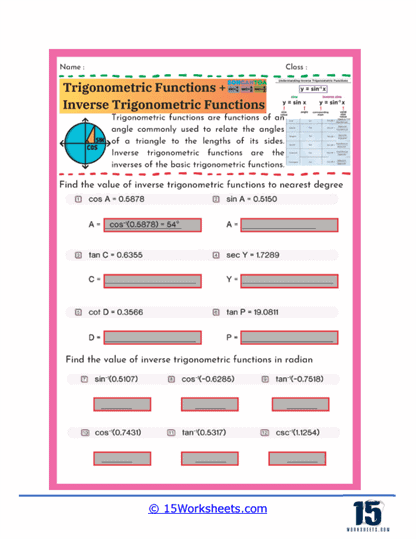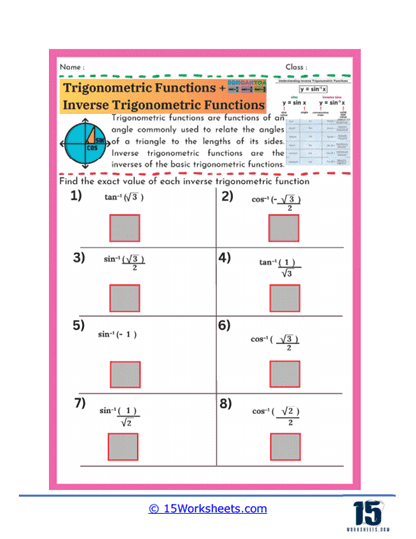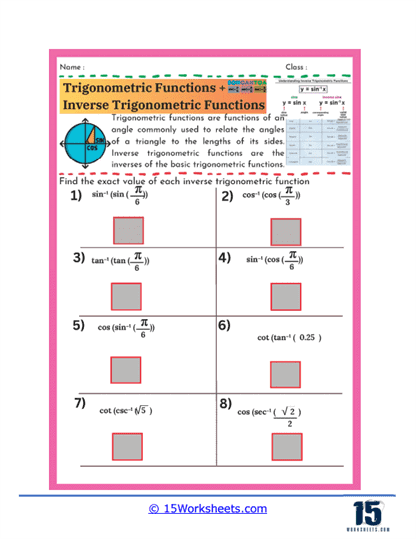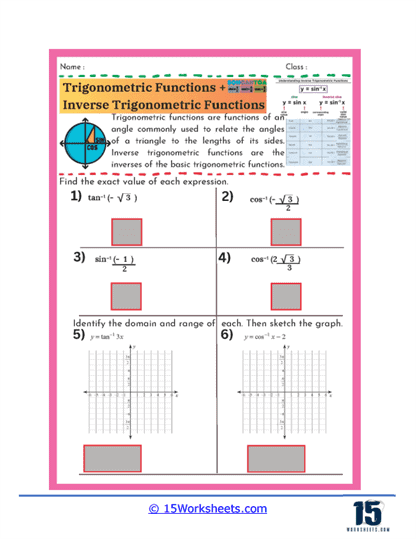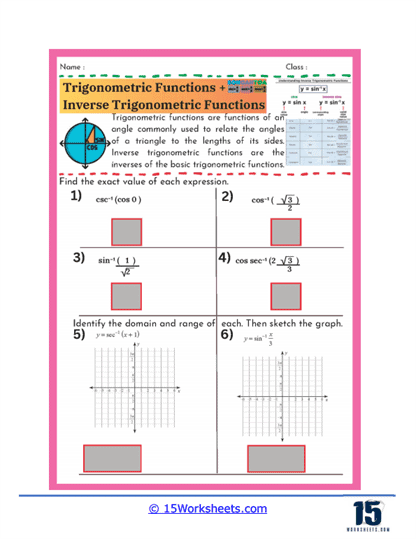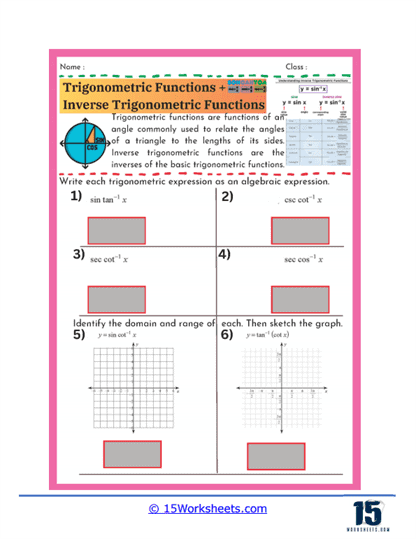Trigonometric Functions Worksheets
About These 15 Worksheets
These worksheets will help students develop a deep understanding of trigonometric concepts. These worksheets cover a wide range of topics related to trigonometric functions, from basic function evaluations to more complex problems involving inverse functions, identities, and graphing. Each type of worksheet is designed to focus on different aspects of trigonometry, ensuring that students gain comprehensive knowledge and the ability to apply this knowledge to solve real-world problems.
One of the primary types of exercises found on these worksheets involves the evaluation of basic trigonometric functions for given angles, especially in the context of right-angled triangles. Students are typically provided with the lengths of the sides of a triangle and are asked to find the values of sine, cosine, and tangent for specific angles. This exercise helps students solidify their understanding of the fundamental trigonometric ratios and their applications in right-angle triangles. It also reinforces the relationship between the angles and sides of a triangle, a foundational concept that is crucial for solving more advanced trigonometric problems.
Another common type of exercise focuses on the application of trigonometric identities. These problems require students to simplify or prove trigonometric expressions using identities such as the Pythagorean identities, sum and difference formulas, double-angle formulas, and more. These exercises not only help students become familiar with these identities but also teach them how to apply these formulas in different contexts. The ability to recognize and use these identities is a critical skill, as it allows students to simplify complex expressions and solve trigonometric equations more efficiently.
Inverse trigonometric functions are another important topic covered in these worksheets. Students are asked to find the angle that corresponds to a given trigonometric value, essentially reversing the trigonometric function. This concept is particularly important in applications where you need to determine an angle given certain information about the sides of a triangle. These worksheets often include problems where students must use both the direct trigonometric functions and their inverses, reinforcing the relationship between these two types of functions and helping students understand how they complement each other in solving trigonometric problems.
Graphing trigonometric functions is another key area covered in these worksheets. Students learn how to sketch the graphs of sine, cosine, and tangent functions, as well as their transformations. These exercises often require students to identify the amplitude, period, phase shift, and vertical shift of a given trigonometric function, and then use this information to accurately graph the function. Understanding how to graph these functions is crucial for visualizing trigonometric relationships and for solving problems that involve periodic behavior, such as those found in physics and engineering.
Some worksheets include word problems that apply trigonometric concepts to real-world situations. These problems often involve finding the height of a building, the distance across a river, or the angle of elevation of an object in the sky, using trigonometric functions. Such exercises are particularly valuable because they demonstrate the practical applications of trigonometry, showing students how the concepts they learn in the classroom can be used to solve problems they might encounter in everyday life.
This collection of worksheets contains exercises that involve the use of special angles, such as 30°, 45°, and 60°, which are commonly found in many trigonometric problems. Students might be asked to find the exact values of trigonometric functions at these angles without using a calculator, which helps them memorize these values and understand their significance. Working with these special angles also prepares students for solving problems involving trigonometric equations, where recognizing these angles can lead to quicker and more accurate solutions.
What Are Trigonometric Functions?
Trigonometric functions are mathematical functions that relate the angles of a triangle to the lengths of its sides. These functions are fundamental in the study of geometry, especially in the context of right-angled triangles, but they also have applications that extend far beyond basic geometry. The primary trigonometric functions are sine (sin), cosine (cos), and tangent (tan), and they are complemented by their reciprocal functions: cosecant (csc), secant (sec), and cotangent (cot). Additionally, inverse trigonometric functions, such as arcsine, arccosine, and arctangent, are used to find angles when the values of the trigonometric functions are known.
At its core, each trigonometric function represents a specific ratio of the sides of a right triangle relative to one of its angles. Here’s a breakdown of the primary trigonometric functions:
Sine (sin) – The sine of an angle is the ratio of the length of the side opposite the angle to the length of the hypotenuse (the longest side of a right triangle).
Cosine (cos) – The cosine of an angle is the ratio of the length of the adjacent side (the side next to the angle) to the length of the hypotenuse.
Tangent (tan) – The tangent of an angle is the ratio of the length of the opposite side to the length of the adjacent side.
Cosecant (csc) – The cosecant is the reciprocal of the sine function.
Secant (sec) – The secant is the reciprocal of the cosine function.
Cotangent (cot) – The cotangent is the reciprocal of the tangent function.
These functions are not only applicable to triangles but also to wave phenomena, circles, and oscillatory systems due to their periodic nature. They are defined not only for angles between 0° and 90° but for all real numbers, making them versatile tools in mathematics and physics.
Real World Applications
Trigonometric functions are indispensable in various real-world applications where they help in making informed and accurate decisions. Some key areas where trigonometric functions are vital include:
Engineering – Engineers use trigonometry to design and analyze structures, ensuring they can withstand forces such as gravity, wind, and earthquakes. For example, in civil engineering, trigonometric functions help in calculating the slope of roads, bridges, and other infrastructures. Electrical engineers use sine and cosine functions to analyze alternating current (AC) circuits, where voltage and current are often modeled as sine waves.
Navigation and Aviation – Pilots and navigators use trigonometry for determining courses, calculating distances, and understanding angles of approach or departure. For instance, the bearing from one point to another and the angle of elevation or depression in flight paths are determined using trigonometric functions.
Architecture – Architects rely on trigonometric principles to create designs that are not only aesthetically pleasing but also structurally sound. For example, trigonometric functions help in calculating the loads that roofs can bear, the angles of supports, and the layout of buildings on a site, ensuring that they can support the intended structure.
Physics – In physics, trigonometric functions are crucial for understanding waves, oscillations, and periodic motion. They describe the behavior of pendulums, springs, and light waves. For example, the motion of a pendulum can be modeled using sine or cosine functions, which helps in predicting its position at any given time.
Astronomy – Astronomers use trigonometry to calculate distances to stars and planets, the orbits of celestial bodies, and the position of objects in the sky. The use of trigonometric parallax is one way to determine how far away stars are from Earth.
Computer Graphics – Trigonometry plays a significant role in computer graphics, where it is used to create realistic animations, model lighting, and render images. It helps in rotating and scaling objects, simulating physical phenomena like wave motion, and projecting 3D objects onto a 2D screen.
Medical Imaging – In medical fields such as radiology, trigonometry is used in the reconstruction of images from data obtained through techniques like CT scans and MRI. These images are generated by using algorithms that rely heavily on trigonometric calculations.
Sound Engineering and Music – Sound engineers use trigonometry to understand sound waves, which are typically represented as sinusoidal functions. This understanding allows them to manipulate audio signals effectively, optimizing sound quality in recordings, live performances, and audio systems.


